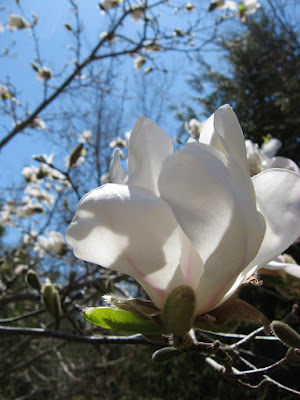
Moonlight and magnolias - a vision typically associated with the old South, but let's consider my recent find on a lunchtime walk: noonlight and magnolias?
I'm always delighted when I discover a new (to me at least) hidden bit of beauty on the Island, and these magnolias certainly qualify.
I found these when a bright spring day enticed me out for a stroll and these images are a great example of breaking the rules - after all, everyone knows you can't take decent photos with harsh mid-day light. I must admit that the softer more diffuse light of dawn or dusk would give a much different effect, but it's simply not an option for this particular garden as it's tucked away in a cedar grove - only the light of mid-day penetrates this hidden gem.
I'm always delighted when I discover a new (to me at least) hidden bit of beauty on the Island, and these magnolias certainly qualify.
I found these when a bright spring day enticed me out for a stroll and these images are a great example of breaking the rules - after all, everyone knows you can't take decent photos with harsh mid-day light. I must admit that the softer more diffuse light of dawn or dusk would give a much different effect, but it's simply not an option for this particular garden as it's tucked away in a cedar grove - only the light of mid-day penetrates this hidden gem.

Magnolias are ancient plants. Fossils belonging to the Magnoliaceae family and dating back to 95 million years ago have been identified.
Because these plants evolved before bees existed, they developed very tough flowers able to avoid damage from the beetles that pollinated them. Their flowers are thick and strong. They do not have distinct sepals or petals, as more modern flowers do; scientists have named the corresponding part of the magnolia flower a tepal.




Try taking some photos in light that breaks the rules, you may be surprised at the results!


Gorgeous results! And I always learn something from your blog...
ReplyDelete